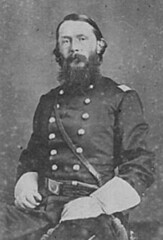
About UsThe Numismatic Bibliomania Society is a non-profit organization promoting numismatic literature. For more information please see our web site at coinbooks.org SubscriptionsThose wishing to become new E-Sylum subscribers (or wishing to Unsubscribe) can go to the following web page link MembershipThere is a membership application available on the web site Membership Application To join, print the application and return it with your check to the address printed on the application. Membership is only $15 to addresses in the U.S., $20 for First Class mail, and $25 elsewhere. For those without web access, write to: David M. Sundman, Secretary/TreasurerNumismatic Bibliomania
Society AsylumFor Asylum mailing address changes and other membership questions, contact David at this email address: dsundman@LittletonCoin.com SubmissionsTo submit items for publication in The E-Sylum, just Reply to this message, or write to the Editor at this address: whomren@coinlibrary.com
BUY THE BOOK BEFORE THE COINYou won't regret it! |
- WAYNE'S WORDS: THE E-SYLUM FEBRUARY 28, 2010
- NEW BOOK: GIESECKE & DEVRIENT - BANKNOTE PRINTING 1854 TO 1943
- NEW BOOK: ADVENTURE ACROSS THE NATIONAL PARKS
- NEW BOOK: A GRIFFIN IN HER DESK BY POERIO & CLIFFORD
- BOOK REVIEW: CURIOUS CURRENCY BY ROBERT D. LEONARD
- ANS LIBRARY CATALOG NAMING CONTEST DEADLINE EXTENDED
- DATABASE OF TRANSLATED NUMISMATIC TERMS AVAILABLE
- STEVE FELLER: LINCOLN CENTS BY THE NUMBERS
- MORE ON FRENCH NUMISMATIC MUSEUM CHANGES
- COINSWEEKLY - AN INTERNET WEBZINE
- THE TERM FOR PAPER PRESSED INTO COIN FORM: STADSOORD
- ANOTHER EARLY FIVE-POINTED STAR ON A U.S. COIN
- MORE ON THE GEN. WILLIAM HAINES LYTLE MEDAL
- ON 18TH CENTURY MONETARY UNITS
- MORE ON COIN AND MEDAL DESIGNS WITH TWO SETS OF DESIGNER INITIALS
- JOHN HABERLE: AMERICAN MASTER OF MONEY PAINTINGS
- 1872 NATIONAL BANK NOTE REPORTER AND FINANCIAL GAZETTE SOLD
- THE MICHAEL HALL COLLECTION OF RENAISSANCE AND LATER MEDALS
- NOTES FROM E-SYLUM READERS: FEBRUARY 28, 2010
- DICKIN MEDAL AWARD CEREMONY HELD FOR BOMB-SNIFFING DOG TREO
- 1859 MASSACHUSETTS TIME CAPSULE YIELDS COINS AND DOCUMENTS
- ARTICLE HIGHLIGHTS MICHIGAN MAN'S WWII SHORT SNORTER
- U.K. WOMAN ARRESTED FOR FAILING TO REPORT COIN FOUND AS A CHILD
- DEFACED CURRENCY GALLERY ON FLICKR
- FENG SHUI: GLUE GOLD COIN TO YOUR DOORSTEP FOR LUCK
- FEATURED WEB SITE: PARTHIA.COM
WAYNE'S WORDS: THE E-SYLUM FEBRUARY 28, 2010

Among our new subscribers this week are Chuck Avent, courtesy of Warner Talso, Laurent Stainvurce, J. Kagan, Charles Avent, Ursula Kampmann and Colin Gullberg. Welcome aboard! We now have 1,335 subscribers.
This week we open with word of a new book the German banknote printing firm Giesecke & Devrient, announcements of two new titles aimed at young numismatists and a review of Bob Leonard's book, Curious Currency.
Other topics include an update on the situation at numismatic museums in France, the term for coins made of pressed paper, the Gen. William Haines Lytle medal and more. To learn about the numismatic aspects of feng shui and Detroit's male-only saloon, read on.
Wayne Homren
Numismatic Bibliomania Society
NEW BOOK: GIESECKE & DEVRIENT - BANKNOTE PRINTING 1854 TO 1943
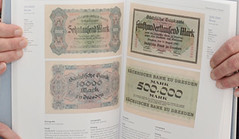 Giesecke & Devrient (G&D) today unveiled a new book on the history of banknote printing. The historical work follows developments in banknote production at the company from 1854 to 1943. The book has been co-written by Dr. Franziska Jungmann-Stadler, Head of the HypoVereinsbank's Banknote Collecting Foundation, and Ludwig Devrient, whose ancestors include founding members of the technology group. Dr. Jungmann-Stadler and Ludwig Devrient are both respected banknote experts of many years' standing.
Giesecke & Devrient (G&D) today unveiled a new book on the history of banknote printing. The historical work follows developments in banknote production at the company from 1854 to 1943. The book has been co-written by Dr. Franziska Jungmann-Stadler, Head of the HypoVereinsbank's Banknote Collecting Foundation, and Ludwig Devrient, whose ancestors include founding members of the technology group. Dr. Jungmann-Stadler and Ludwig Devrient are both respected banknote experts of many years' standing.
Walter Schlebusch, G&D Management Board member and Group Executive of the Banknote business unit, says: "For Giesecke & Devrient, a company particularly aware of its long tradition having always been family-owned, the opportunity to cooperate with these two authors was too good to miss. Their book, entitled âGiesecke & Devrient - Banknote Printing 1854 to 1943', presents the early days of banknote production at G&D and makes this history accessible to a wider audience for the very first time." Using the notes printed by G&D over the years, the publication reflects the history of currency through the 19th and 20th centuries, and is an excellent reference work for anyone with an interest in the historical development of banknote printing.
The book, which is illustrated with color pictures throughout, traces the history of banknote production at G&D's original East German headquarters in Leipzig from 1854 to 1943. Because of the destruction inflicted during World War II, up until German reunification, only patchy information was available regarding these early years. In order to obtain a comprehensive overview of the period, the two authors took it upon themselves to carry out intensive research in cooperation with archives, museums and collectors, as well as with various central banks. The State Archive in Leipzig proved a particularly rich source of information, housing significant quantities of material that could be used to reconstruct G&D's fledgling history.
The book contains detailed information on all the banknotes printed by G&D between 1854 and 1943, and their respective issuers. Individual chapters are arranged chronologically according to initial order date and include a list of all the orders placed by each issuer. It is illustrated with numerous pictures, some of which show very rare and valuable banknotes. Each note is accompanied by an explanation of its iconography, the particular printing techniques used, and details of the paper manufacturer. The text has been produced in both German and English.
âGiesecke & Devrient - Banknote Printing 1854 to 1943' is published by the Regenstauf-based publishing house H. Gietl Verlag & Publikationsservice GmbH on behalf of Giesecke & Devrient, Munich. Copies of the publication are available from all good bookshops or direct from the publisher (www.gietl-verlag.de).
Details about the book
266 pages, 21 x 29.7 cm, numerous color illustrations, hardcover
ISBN: 978-3-86646-527-5
Price: â¬69.00
To read the complete article, see: Giesecke & Devrient Issues Historical Work on the History of Banknote Printing (www.printerslounge.com/en/node/54387)
NEW BOOK: ADVENTURE ACROSS THE NATIONAL PARKS
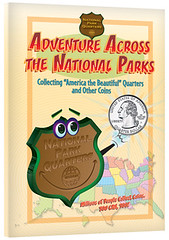 Whitman Publishing has released Adventure Across the National Parks, a book that introduces young people to coin collecting. The 96-page softcover book retails for $4.95 and is available online at www.WhitmanBooks.com, and through bookstores and hobby shops nationwide.
Whitman Publishing has released Adventure Across the National Parks, a book that introduces young people to coin collecting. The 96-page softcover book retails for $4.95 and is available online at www.WhitmanBooks.com, and through bookstores and hobby shops nationwide.
Subtitled Collecting 2010-2021 "America the Beautiful" Quarters and Other Coins, the new book poses the question, "How do you pay for things you buy at the store? You probably use dollar bills. Grownups with bank accounts can write a check, or pay with a plastic debit card. In this book, we look at another kind of money, one that people like to collect as well as spend: coins!"
Young readers are encouraged to "Join the World's Oldest Hobby," enjoyed by millions of Americans who collect the U.S. Mint's state quarters and national park quarters.
The contents of Adventure Across the National Parks include:
- A list of honored sites in the National Park quarters program, by state
- A foreword by Aaron J. McKeon, author of Whitman's upcoming America's Beautiful National Parks: A Handbook for Collecting the New National Park Quarters
- An introduction by hobby legend Q. David Bowers
- The History of Coins
- Collecting Coins
- The Parts of a Coin
- How Are Coins Made?
- How Much is a Coin Worth?
- How to Examine Your Coins
- How to Grade Your Coins
- Grading Terminology
- A Photo Guide to Grading
- Buying Coins
- Storing Your Coins
- Collecting National Park Quarters
- The 56 Sites in the National Park Quarters Program
- Pocket Change You Can Collect
- Older Coins You Can Collect
- Join a Club
In addition to encouraging young readers to collect coins, a goal of Adventure Across the National Parks is to spark an interest in the nation's natural resources. "As you collect the quarters," writes McKeon in the foreword, "be sure to read up on the places they depictâI'm sure they'll surprise you. There are lush rainforests and remote glaciers, glittering ice caves and rolling grasslands, sprawling forests and scenic parkways. There are a few places you are really going to want to drive to and others that you can only see by boat or, better, kayak."
"Each of the coins is bound to be exciting," writes Bowers in the introduction. "Every one of us will learn something new." Adventure Across the National Parks has stories and facts about every national park, forest, and other site honored in the Mint's quarter-dollar coinage program, which runs through 2021.
For more information, see: Adventure Across the National Parks (www.whitmanbooks.com/Default.aspx?Page=81&ProductID=0794828884)
NEW BOOK: A GRIFFIN IN HER DESK BY POERIO & CLIFFORD
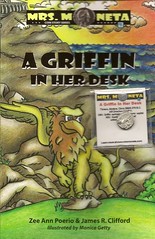 A new numismatic book arrived at my doorstep last week. Zee Ann Poerio of Ancient Coins in Education (ACE) sent me a few copies to give away at the next numismatic event for kids in Northern Virginia. I met Zee Ann several years ago in Pittsburgh. She's a teacher and I'd read about her ACE classroom activities in the local newspaper. Later she and her students came and gave a great program on ancient coins to the Coins4Kids group at a Pennsylvania Association of Numismatists show near Pittsburgh.
A new numismatic book arrived at my doorstep last week. Zee Ann Poerio of Ancient Coins in Education (ACE) sent me a few copies to give away at the next numismatic event for kids in Northern Virginia. I met Zee Ann several years ago in Pittsburgh. She's a teacher and I'd read about her ACE classroom activities in the local newspaper. Later she and her students came and gave a great program on ancient coins to the Coins4Kids group at a Pennsylvania Association of Numismatists show near Pittsburgh.
I was happily surprised to see that the book's author (along with Jamie Clifford) was none other than Zee Ann herself. The book, titled A Griffin in Her Desk is the first in the planned "Mrs. Moneta Coin Story Series."
Co-author Clifford's name was familiar as well - we reviewed his book Double Daggers in an earlier issue of The E-Sylum. But although as E-Sylum editor I'm often among the first to know about a new numismatic book, I opened the cover to learn it had already been reviewed by ANA Governor Scott Rottinghouse, Kerry Wetterstrom, Editor of The Celator, Wayne Sayles of the Ancient Coin Collectors Guild and ANS Librarian Elizabeth Hahn, among others.
The Mrs. Moneta series has its own web site, and I'm reprinting several passages below. Congratulations to both authors on a wonderful effort; I hope to read a copy myself before passing it on to a young numismatist.
The authors write:
The idea for the Mrs. Moneta Coin Story Series was inspired by our lifelong interests in classical ancient history, numismatics and the desire to share our passions with kids of all ages. We strongly feel that studying the ancient world can help all of us better understand the world we live in today.
Nothing sparks the imagination of a child's mind more than a tangible link to the past. Children are in awe when they learn that ancient civilizations used coins just as we use them today. A child makes a connection to these coins and discovers the similarities. They are motivated to investigate more, and then they wonder. . . Who owned these tiny pieces of history? What were they used for? Would a child in ancient times save his money to buy a toy like I do today? Through this tiny piece of history, held in the palms of their hands, children learn and they remember.
We hope to provide that tangible link by making available a replica of an ancient coin to coordinate with each book in the series. Our goal is to make ancient history and numismatics fun and exciting. Beginning with the first book in our series, A Griffin In Her Desk, we explore mythological creatures that were minted on ancient Greek coins. Become part of this learning adventure as Mrs. Moneta introduces a friendly Griffin and other wonders of classical Greek mythology.
Kerry Wetterstrom writes:
Mrs. Moneta is the teacher we all dream of having! She makes the classics, ancient history, Greek mythology, and reading fun and educational, with her own magical twist. You and your child will love this book, and find yourselves wanting to learn and read more about the world that is introduced to us by Mrs. Moneta.
Elizabeth Hahn writes:
I loved reading "A Griffin In Her Desk." What a fun story and truly wonderful way to bring ancient history, mythology, and numismatics to life! I especially enjoyed the emphasis on language and your efforts to include a manageable amount of new Latin vocabulary that was effectively scattered (and repeated) throughout the story.
I think you have succeeded in making ancient history and numismatics fun and exciting to a younger audience. I can only say that I am already looking forward to what future adventures will come with Mrs. Moneta and her class!
My book came together with a reproduction Griffin coin, a nice copy of the silver drachm of Thrace, Abdera, circa 386/5-375 B.C. (in the image, it's in a 2x2 glued to the front cover). Again, my congratulations to the authors. I encourage E-Sylum readers everywhere to order copies for their young numismatist friends.
For more information, see: www.mrsmoneta.com
BOOK REVIEW: CURIOUS CURRENCY BY ROBERT D. LEONARD
 Another book that came across my desk this week was an early review copy of Bob Leonard's Curious Currency.
My first thoughts were in immediate agreement with a sentiment from Whitman Publishing's press release:
Another book that came across my desk this week was an early review copy of Bob Leonard's Curious Currency.
My first thoughts were in immediate agreement with a sentiment from Whitman Publishing's press release:
Richly illustrated with full-color photographs and drawings, and handsomely bound in hardcover, this 160-page book is a wonderful bargain at $12.95. It's a great way to get kids interested in collecting. . . a serious compendium for the student of numismatics. . . and a fun read for anyone interested in that ancient and always popular topic, MONEY!
It's a small guidebook (152 pages), but sumptuously illustrated in full color and well documented in 25+ pages of notes, bibliography, photo credits and index (there I go again, looking at the back of the book first). It really is a bargain - in fact, I heard one book dealer understandably grouse that it's hard to make any money on a book published at such a low sticker price. But bibliophiles and numismatists are the winners in this equation.
I was curious myself when I read the book's subtitle: "The Story of Money From the Stone Age to the Internet Age". I was expecting a book on Odd and Curious money, not ALL money. So I had to look and I did find a section on normal coins, several pages worth, although the emphasis was on odd-shaped coins, oversize coins, cut and plugged coins, countermarked coins, etc.
I do think the subtitle greatly oversells the scope of the book, but it's a minor quibble. It is after all a guidebook, focused on breadth rather than depth. As a bibliophile whose shelves once held a dozen other references on Odd and Curious money (Quiggin, Einzig, Opitz, the Schulman Howard Gibbs collection sales), Leonard's book is a handy one to have as a starting point.
It would be a fair question to ask why another guide book to Odd and Curious currency is needed when Opitz' 2000 book, An Ethnographic Study of Traditional Money is available. But that was published privately ten years ago and may not be so available anymore. Besides, every book has its own niche and I've never been one to turn down a 2nd, 3rd or Nth book on an interesting topic. The authors were cooperating, not competing. Bob Leonard lists Charles Opitz first in the Acknowledgements, and he appears on page 94 standing next to a huge piece of Yap stone money.
E-Sylum readers know I'm a fan of all types of unusual numismatic items, and the book is filled with interesting examples, including modern local currencies, 19th century British Labour Exchange Notes, and Pismo Beach Clamshell Money. One neat item I'd never seen before is Abernethy's Rock Money (p117): "Oregon City (Oregon Territory) pioneer merchant George Abernethy made change in his general store in 1844 by gluing miniature promissory notes to chips of flint discarded by Indians."
All in all, a nice piece of work. I think numismatists of all ages and stripes would enjoy it, and I hope to give some copies away to the young numismatists in my area. Like the "Griffin in Her Desk" book, I encourage E-Sylum readers to do the same.
To read the earlier E-Sylum article, see: NEW BOOK: CURIOUS CURRENCY BY ROBERT D. LEONARD (www.coinbooks.org/esylum_v13n08a04.html)
THE BOOK BAZARRE
ANS LIBRARY CATALOG NAMING CONTEST DEADLINE EXTENDED
In 2010, the ANS Library will launch a new and improved library catalog. This catalog needs a name. We ask the creative minds of the numismatic community to help with this. The person who submits the name that is chosen will win a $100 ANS gift certificate, which can be used for a wide variety of ANS purchases, including publications, March 1, 2010, so make sure to get your ideas in before then!
Over 50 submissions have already been made. To submit your entry, please email contest@numismatics.org or mail your entry to the attention of Elizabeth Hahn at the ANS headquarters in NYC. You can submit as many entries as you like.
For details visit: ANS Library Naming Contest (www.numismatics.org/Library/ANSLibraryNamingContest)
DATABASE OF TRANSLATED NUMISMATIC TERMS AVAILABLE
Just over one year ago, I launched a project to create a searchable database of terms needed to internationalize numismatic web sites. To view the result, you are invited to visit parthia.com/pdc/numismatic_terms.htm .
You will currently see 1,100 translated terms and phrases in twelve languages, and there is a help page to assist you in using the database.
A team of volunteers has been working throughout the past year to provide the translations. The Catalan, Dutch, French, German, Italian, Portuguese, Russian and Spanish translations are complete (or nearly so) while work is still in progress for Greek, Persian and Arabic.
I extend my sincere thanks to the volunteers who have made, and continue to make, this project possible:
- Alfredo De La Fe
- Carlos Verdura
- David Wigg-Wolf
- Giulio De Florio
- Jorge Cavalheiro
- Joris Aarts
- Khodadad Rezakhani
- LluÃs Mendieta
- Mostafa Faghfoury
- Patrick Pasmans
- Pierre R. Monney
- Uwe Ellerbrock
- Vadim Nikitin
- Walter Bloom
The translations database will remain on the Internet for free use by any visitor.
Your comments, constructive criticism and suggestions are welcome. If you would like to add a language, correct the existing translations, add a new term or become a volunteer editor, please email me at chris@parthia.com .
- Billon
- Bracteate
- Brass
- Brockage
Thanks for making this resource available! Chris noted that this translation database was created to support the Sylloge Nummorum Parthicorum project which recently began appearing in Google searches. On the page at http://sylloge.org we learn that the SNP will be a nine volume print edition in sylloge format of the Parthian coins in the cabinets of Berlin, London, New York, Paris and Vienna. -Editor
STEVE FELLER: LINCOLN CENTS BY THE NUMBERS
Steve Feller writes:
"Here is a bit more on the Lincoln cent from a statistical point of view. In an article I recently submitted to "The Numismatist" I contend that the demise of the Lincoln cent is clearly underway. The article is entitled"The Rise and Fall of the Lincoln Cent."
Attached are two of several graphs I produced that clearly show the trend. The graphs show the cumulative mintages of Lincoln cents and the change in the per capita production of Lincoln cents per decade. The great mintages of the coin peaked around 1990! We are rapidly reaching stagnation and not just because of the current economy- clearly it is part of a long range trend. Incidentally, just over 450,000,000,000 Lincoln cents have been struck to date."
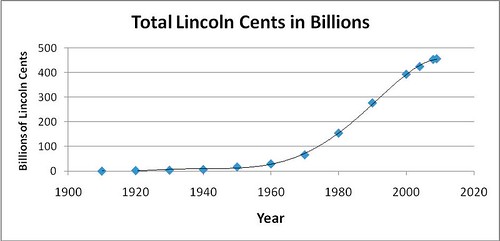

THE BOOK BAZARRE
MORE ON FRENCH NUMISMATIC MUSEUM CHANGES
Ted Buttrey of Fitzwilliam Museum in Cambridge, England writes:
This is just a misunderstanding. The Bibliotheque Nationale houses two different collections: the Museum, which has antiquities -- pots, gems, etc. -- with its own exhibition room; and the Cabinet de Medailles, the coin collection. It is the Museum that is to be reordered, or perhaps even closed; but the collection of coins, and access to it, will not be touched.
1. The museum will no longer exist as such, although the Cabinet of medals remain for the consultation of researchers.
2. The works will be almost entirely retained in reserve.
-Editor
"The item about the closing of the Coin Cabinet at the Bibliotheque Nationale is incorrect, per Michel Amandry, the Director. Hadrien Rambach confirms that he was just passing on something he had seen. The full story is described here."
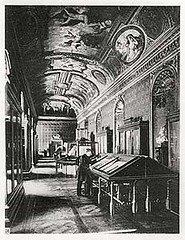 Recently, throughout the numismatic world emails were sent that referred to a website spreading the news that the Cabinet des Medailles was in imminent danger of being closed. This information even made it into the political press. In its June 2010 edition the magazine Spiegel reported that the entire academic world mobilized against the announced closure which the Director General Jacqueline Sanson wants to be understood as a "renovation" and a "new presentation".
Recently, throughout the numismatic world emails were sent that referred to a website spreading the news that the Cabinet des Medailles was in imminent danger of being closed. This information even made it into the political press. In its June 2010 edition the magazine Spiegel reported that the entire academic world mobilized against the announced closure which the Director General Jacqueline Sanson wants to be understood as a "renovation" and a "new presentation".
This is puzzling. What is really behind all this? A simple look at the official website of the Bibliotheque nationale can clarify things. Anyone who has visited the Parisian Cabinet des Medailles can vouch for the fact that a renovation is long overdue. Plus, after the relocation of a part of the departments the building has many large, empty rooms that are intended to be put to good use again. A total renovation of the old Bibliotheque nationale will be carried out, therefore, that has already started in 2009. Responsible is the architectural office of Bruno Gaudin who is quite experienced in building or renovating big libraries in France.
Michel Amandry, Conservateur general of the Departement des Monnaies, Médailles et Antique, announces that the renovation will consist of two stages of which only the second concerns the Cabinet des medailles. This second phase is likely to commence in 2013/14 and will be finished by 2017. During the renovation the coin cabinet continues to be accessible, albeit with limitations. At present, the academic staff selects from their 600.000 objects those that are most frequently asked for by researchers. While the work is going on, roughly one third of the material will be available.
Hence, the Cabinet des Medailles is about to undergo a change - but it certainly is in no danger of being closed altogether. After all, changes are inevitable if an institution wants to survive the next century.
To read the complete article, see: Much ado about the Cabinet des Medailles of the Bibliotheque nationale (www.coinsweekly.com/en/page/4?&id=95)
To read the earlier E-Sylum article, see: TWO MAJOR FRENCH NUMISMATIC MUSEUMS SET TO CLOSE (www.coinbooks.org/esylum_v13n08a11.html)
COINSWEEKLY - AN INTERNET WEBZINE

Since October 16th, 2009, CoinsWeekly is online, a new and no-cost journal for all coin collectors with an English edition at www.coinsweekly.com and a German one at www.muenzenwoche.de.
Here some information about CoinsWeekly: Every Friday sees a new issue providing information for anyone who likes collecting coins and wants to better assess the coin market. A comprehensive archive compiles all scientific articles published so far as well as selected news, mainly in the field of Cultural Property Issues. Hence, a constantly enlarging range of interesting material is available to the collector who can choose, for instance, from
- Professional articles on numismatic-historical topics
- How-to-do-it pages for beginners
- Numismatic guidebooks to individual cities and regions
- Reports on recent events in the numismatic world
- Book presentations
- Auction sale previews
- Auction sale reviews
- Presentation of sale lists
- Related links to websites with numismatic contents
To read Coins Weekly, see: www.coinsweekly.com
THE TERM FOR PAPER PRESSED INTO COIN FORM: STADSOORD
Last week Gar Travis asked:
Can someone supply the term for paper pressed into "coins" or the process there of? There were "coins" during the Spanish siege of Leyden in 1574 which were made of covers and pages of church missals, hymnals for obsidional use, but the term escapes me. I believe it begins with an 'S' and while that may be only slightly helpful, it is all that I have.
Tony Tumonis of Tucson writes:
The term he is looking for is Stadsoord. If you are planning a trip to Leyden they still commemorate the lifting of the Siege on the 3rd Day of October in a celebration eating the same food that their beseiged ancestors ate, a meal of herring, white bread and hutspot (A stew made of carrots and onions).

Joe Boling wonders:
Did John Sandrock really mean it when he said "There are eight known specimens..." of Leyden card siege money? Is it that rare? Or did he mean eight known types?
To read the earlier E-Sylum article, see: QUERY: TERM FOR PAPER PRESSED INTO COIN FORM SOUGHT (www.coinbooks.org/esylum_v13n08a14.html)
ANOTHER EARLY FIVE-POINTED STAR ON A U.S. COIN
Regarding Mark Borckardt's earlier question on the earliest appearance of a five-pointed star on any U.S. Federal regular-issue coin, Dick Doty writes:
Isn't there a five-pointed star on the 1714 Gloucester token?
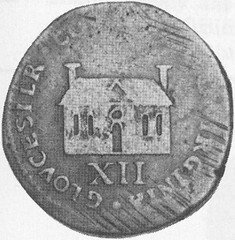

To read the earlier E-Sylum article, see: MORE ON THE EARLIEST FIVE-POINTED STAR ON A U.S. COIN (www.coinbooks.org/esylum_v13n08a12.html)
MORE ON THE GEN. WILLIAM HAINES LYTLE MEDAL
Jeffrey P. LaPlante submitted the following detailed response. Thanks! -Editor
The Brigadier Gen. William Haines Lytle medal referred to in the article was in fact given to him just 11 days prior to his death by the 10th Ohio Infantry he served with during the Civil War. The medal is a Maltese cross and was presented to the General while on military duty in 1863. Whitelaw Reid's biographical sketch of Lytle (Ohio in the War, Volume I, page 881) summarized the event:
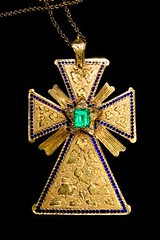 The General was born in Cincinnati and graduated from Cincinnati College; he served in the Mexican American War with the 2nd Ohio Volunteers as a Captain of Infantry. He was a lawyer and also a politician with some success as the latter. He successfully ran for and was elected to the State legislature but was defeated while running for Lieutenant Governor of his home state of Ohio. When the Civil War opened in 1861 Lytle used some of his political acumen and military connections in order to secure a command and was given the 10th Ohio Volunteers and the rank of Colonel.
The General was born in Cincinnati and graduated from Cincinnati College; he served in the Mexican American War with the 2nd Ohio Volunteers as a Captain of Infantry. He was a lawyer and also a politician with some success as the latter. He successfully ran for and was elected to the State legislature but was defeated while running for Lieutenant Governor of his home state of Ohio. When the Civil War opened in 1861 Lytle used some of his political acumen and military connections in order to secure a command and was given the 10th Ohio Volunteers and the rank of Colonel.
He acquitted himself with honor and bravery while in a fight at Carnifex Ferry in September of 1861 and was wounded in that battle. He returned home to recuperate and then was made the Commander of a prisoner of War camp in Bairdstown, Kentucky. He again used his considerable political and military connections to secure a position as Brigade commander under Maj. Gen. Ormsby Mitchell's division where he again managed to get himself wounded and taken as a prisoner of War. He was made party to a prisoner of War exchange and again returned home to recuperate.
You would think at this point the man would have the good sense to realize that this was not baseball and the three strikes and you're out rule does not allow you to come back and play a double header next week. But no, the General again assumes command of a Brigade of Infantry under General William S. Rosecrans at that time. As you probably guessed he was mortally wounded at the Battle of Chickamauga in Georgia while leading a counter attack on horseback.
William Haines Lytle was also a poet of some notoriety and his famous poem Antony and Cleopatra, and others were read at night around the living rooms of all Americans, both Southern and Northern. While he laid dead on the field of battle Confederate soldiers read his poems while standing guard over his body, a testament to the courage of the man.
This passage is from one of Lytle's most famous poems, Antony and Cleopatra:
'And for thee, star-eyed Egyptian!
Glorious sorceress of the Nile,
Light the path of Stygean horrors
With the splendor of thy smile;
Give the Caesar crowns and arches,
Let his brow the laurel twine,
I can scorn the Senate's triumphs,
Triumphing in love like thine.' "
The hill where he died is now known as Lytle hill in the Chickamauga National Military Park. Lytle referred to the medal in a letter to his sister on 16 August 1863: "I almost forgot to say that my cross was presented in due form a few days since by the officers of the 10th a delegation of whom came away down here [to Bridgeport AL] for the purpose."
This was one of his last letters the great General would write and six weeks before his death, when presented the Maltese cross by members of his old regiment, Lytle ended his speech in this fashion: "That the day of ultimate triumph for the Union arms, sooner or later, will come, I do not doubt, for I have faith in the courage, the wisdom, and the justice of the people. It may not be for all of us here today to listen to the chants that greet the victor, nor to hear the brazen bells ring out the new nuptials of the States. But those who do survive can tell, at least, to the people, how their old comrades, whether in the skirmish or the charge ... died with their harness on, in the great war for Union and Liberty."
To read the earlier E-Sylum article, see: CINCINNATI GOLD EXHIBIT (www.coinbooks.org/esylum_v13n08a26.html)
ON 18TH CENTURY MONETARY UNITS
Bruce Smith writes:
The October-December 2009 issue of The Asylum arrived yesterday (23 February 2010) and once again is filled with fascinating and obscure information. For me the highlight was the front cover, which reproduced a small portion of one page of a table of 18th century monetary systems and exchange rates.
That one small section contained five monetary units not found in Frey's Dictionary of Numismatic Names -- which lists between 4,000 and 5,000 world monetary units and terms. The previously unlisted terms, all from Italy, are: BAYOC (6 Quatrini = 1 Bayoc; 10 Bayocs = 1 Julio); JULE (18 Soldi = 1 Jule; 3 Jules = 1 Testoon); JULIO (10 Bayocs = 1 Julio; 3 Julios = 1 Testoon); PAULO (40 Quatrini = 1 Paulo); and PICHILI (6 Pichili = 1 Grain; 8 Pichili = 1 Ponti).
The Julio and Jule are apparently different names for the same term. Whether there are coins corresponding to those denominations, I do not know. The Pichili is certainly the same as or a version of Frey's Picciolo (6 Picciolo = 1 Grano). The Paulo may be related to Frey's Paolo, but the exchange rates don't seem to match.
As for the origins of the terms, Julio, Jule and Paulo are probably named after some ruler or pope. Pichili, no doubt is a form of Piccolo, which according to Adrian Room's book on the origins of coin denominations, comes from "denaro piccolo" (lesser denaro or coin). I was not familiar with the term Ponti. It is listed in Frey though he does not give the origin or the term.
Bayoc was a mystery to me at first. I checked my card file of coin denominations, and believe this is a form of Baiocco (a well known Italian denomination), which also appears as Baio, Bajocco, Bioc, Byok and Baiock. One source says the origin of this word is Italian "bajo" meaning brown -- referring to the color of the coin (originally billon, later copper).
Another source says the term comes from Baiocas, the Latin name of the city of Bayeux as it appears in inscriptions of Merovingian coins. Bayeux, of course, is in Normandy in northern France, but Italy (at least the northern part) was once part of the empire of Charlemagne.
So where can I see the rest of that 18th century table of exchange rates? Has it been posted on the internet?
The American edition that Eric Newman wrote about and David Fanning identified can be seen here:
www.archive.org/stream/newsystemofmoder02guth#page/n744/mode/1up
However, for layout reasons, I used a sample page from a different edition of the same book, which can be seen here:
books.google.com/books?id=ZlsBAAAAYAAJ&pg=PA1023
.
MORE ON COIN AND MEDAL DESIGNS WITH TWO SETS OF DESIGNER INITIALS
Tim L. Shuck writes:
You asked in the last E-Sylum whether the 2010 cent reverse was the first time two designer's initials were included on the same side of a U.S. coin.
The proof and 'regular strike' platinum eagles of the "Foundations of Democracy" series, 2006-2008, and the latest 2009 issue, all have two sets of designer initials on the reverse. The bullion issues for this period have the standard Thomas D. Rogers Sr. reverse design. The initials of sculptor/engraver John Mercanti also appear on the obverse of each year. I don't know the names of the designers for any of the proof platinum reverses, designs which have changed yearly.
The image below, taken from the PCGS CoinFacts website, is of the 2007 coin, my favorite design of the type so far; two sets of initials/monograms can be seen on the edges of the shield above ".9995 PLATINUM":
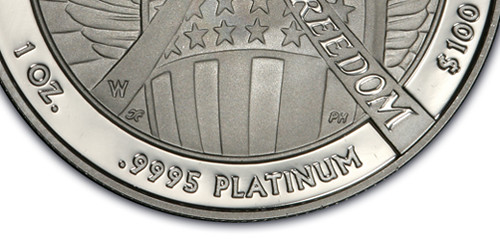
On observing the dual initials on the reverse of the 2010 cent editor Wayne Homren asked last week if there had been a previous instance where two artist's initials had appeared on one side of an American coin. The answer: Yes, numerous times. Perhaps too numerous to mention.
But one instance which should be mentioned is the Oregon Trail Commemorative Half Dollar of 1926 (Breen 7468-7481). It was created by two medallic artists, James Earle Fraser and his wife Laura Gardin Fraser. They combined their initials with a single large F at the right, a small JE over a small LG, so it would read JEF and LGF. Now that's charming!
In another instance in the commemorative half dollar series, the husband and wife team of William Marks Simpson and Marjorie Marks Simpson signed WM + MES on the Norfolk Virginia Tercentennial Half Dollar (Breen 7561). Just letters, no attempt at charm.
But what is really interesting is the subject of signatures on medals. Two artists prepared the medal for an art organization they were both members: The Society of Illustrators Medal of 1950 (Medallic Art Company 50-35). They combined their last name initials C and F into a monogram with the F partially inside the C and the middle arm of the F forming part of the C. The artists: Mario Cooper and Robert Foster. C and F.
The Danish Washington Medal of 1876 (Baker 426) has three signatures: I Christensen, H. Orlik and F. Schmahlfield. The Columbus Milan Medal of 1892 (Eglit 106) was struck by Stefano Johnson (no relation to me -- I wish he was!). Since this was one of their first medals reduced from oversize models and reduced on a die-engraving pantograph, they included the initials of the operator of the reducing machine -- in addition to the signatures of the two Italian artists that prepared the design and made the models! That is significant!
But a United States Mint medal holds somewhat of a world's record - five signatures on one medal! The Duncan Ingram Congressional Medallion of 1855 (Julian NA-26) was struck by the Philadelphia Mint. The five artists are: S. Eastman D, P.F. Cross SC, James B. Longacre -- those signatures appear on the obverse. S. Eastman D and J.B. Longacre SC appear on the reverse. The D is for designer, the SC means sculptor. Interesting that Longacre calls himself a sculptor on the reverse.
With that many signatures we need to identify who did what -- the division of labor. Seth Eastman designed both sides. He gets a "D" on both sides. Peter F. Cross modeled -- or engraved -- the obverse scene. He gets an "SC." He could have modeled the design in clay or plaster, or engraved a die direct. He probably modeled the design oversize and furnish this model to James Barton Longacre, who at the time was chief engraver at the U.S. Mint at Philadelphia.
Longacre probably cast Cross's model making a metal galvano pattern, then using that on the Mint's Hill reducer made a reduction punch. He sunk that punch into a blank die, then added lettering afterwards with letter punches. For the reverse Longacre did all the engraving -- eagle, rays and wreath -- and hand punched all the lettering.
Longacre signed both sides, adding Seth Eastman's name on both sides for the design, and credited Peter Cross for his contribution of the obverse. Whew!
To read the earlier E-Sylum article, see: THE 2010 LINCOLN CENT SHIELD REVERSE DESIGN (www.coinbooks.org/esylum_v13n08a20.html)
JOHN HABERLE: AMERICAN MASTER OF MONEY PAINTINGS
By the early 1880s, Haberle had acquired skills as a draftsman and engraver that prepared him for a career as an illusionistic painter capable of creating visual artistic jokes. Such work was much prized by businessmen, who hung works on their office walls for amusement and bragging rights, and for display in taverns and other places frequented by men. Although classified as a trompe l'oeil artist, Haberle referred to his style as "artistic mechanics."

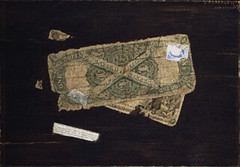
At a time when counterfeiting was serious business â the US Secret Service was established in 1865 to suppress bogus money â paintings featuring US currency were very popular, particularly to decorate saloons. Harnett created the first American currency painting in 1877. When his precisely delineated works were displayed in a New York saloon in 1886, the Secret Service warned him to stop painting money, and Harnett complied.
Haberle, on the other hand, took up the subject with gusto, making US currency a specialty. In 1887, he exhibited a money painting, "Imitation," at the National Academy of Design. Its painstakingly painted stamps and Treasury notes remain convincing on close inspection. A small tintype of the bewhiskered artist underscores the identity of its creator. (Adjacent display cases contain original currency, stamps and photographs similar to those reproduced in several of Haberle's paintings, including "Imitation.")
The purchase of "Imitation" by prominent art collector Thomas Clarke and its subsequent display at the Pennsylvania Academy of the Fine Arts encouraged the painter to continue using money themes in his work. Clarke, who continued to collect and promote the painter's work, said, "No artist has yet equaled Haberle in imitating bills and stamps."
Haberle's next complex canvas on the subject, "Reproduction," containing currency and stamps and readable newspaper clippings alluding to counterfeiting charges, was exhibited at the Art Institute of Chicago that same year, 1887.
It was "U.S.A. (The Chicago Bill Picture)," circa 1889, showing a worn $1 bill atop a tattered $10 note, a one-cent stamp, a piece of tape and a newspaper clipping praising "Imitation" that caused the uproar that brought Haberle to national attention. While "U.S.A." was on display at the Art Institute of Chicago in 1889, a local newspaper critic accused Harberle of perpetuating a fraud by pasting real currency and stamps onto his canvas. Incensed, the artist traveled to Chicago to confront the writer. Using a magnifying glass and paint remover, experts proved the image was indeed fully painted. Within days, the critic retracted his charge, calling the canvas a "true work of imitative art."
Dubbed by one art historian as an "ironic and comedic tour de force," "U.S.A." deliberately sought to goad the government by including the $1 bill's reverse side with its official warning against imitation of US currency. For years it hung in one of Detroit's male-only saloons. "U.S.A." and its attendant brouhaha solidified Haberle's reputation as the most meticulous painter of currency.
In other nearly perfectly rendered views of currency, Haberle continued to depict the warning against counterfeiting on the reverse side of the $1 bill.
This ploy suggests that the artist was neither shy nor humble about his skills nor afraid of its consequences. When the US Treasury warned him to stop painting money, he just painted more detailed and accurate images. In effect, he flaunted his talent and dared anyone to stop him.
Although he painted currency for only four years, during that time â as the uncannily accurate examples in the New Britain show attest â he created some of the most convincing trompe l'oeil images of American money in history. Said fellow money-painter Harnett, "I have never seen such remarkable reproductive talents anywhereâ¦no artist has yet equaled Haberle in imitation of bills and stamps."
To read the complete article, see: âJohn Haberle: American Master Of Illusion' (antiquesandthearts.com/2010-02-09__13-24-02.html&page=2)
1872 NATIONAL BANK NOTE REPORTER AND FINANCIAL GAZETTE SOLD
Regarding last week's item about the eBay sale of a GSA Carson City dollar sale press packet, Joe Boling writes:
Speaking of unexpected realizations at auction, here is a link to a counterfeit detector I had not heard of. It's the "National Bank Note Reporter and Financial Gazette (Formerly Mendelson's)."
 A stained and tattered, with pieces missing, copy of the 15 July 1872 number of this periodical appeared on eBay this week. My snipe was left far in the rear as the lot went to $760 on nine bids from six bidders. This is a newsprint publication lacking the intaglio plates and other features that make some detectors so popular. I've never come close to spending that much for a Heath.
A stained and tattered, with pieces missing, copy of the 15 July 1872 number of this periodical appeared on eBay this week. My snipe was left far in the rear as the lot went to $760 on nine bids from six bidders. This is a newsprint publication lacking the intaglio plates and other features that make some detectors so popular. I've never come close to spending that much for a Heath.
To view the complete auction description, see: NATIOANL BANK NOTE REPORTER 1872 COUNTERFEIT DETECTOR (cgi.ebay.com/ws/eBayISAPI.dll?ViewItem&item=110495340394) To read the earlier E-Sylum article, see: 1974 CARSON CITY DOLLAR GSA SALE PRESS KIT SOLD (www.coinbooks.org/esylum_v13n08a18.html)
THE MICHAEL HALL COLLECTION OF RENAISSANCE AND LATER MEDALS
American born Art collector and connoisseur, Michael Hall, is to sell his exceptional collection of renaissance and later medals in three parts through London based coin dealer and numismatic auction house, A. H. Baldwin & Sons Ltd. Michael Hall has a phenomenal expertise and an enormous breadth of knowledge and appreciation of art across the spectrum. He has inspired top curators and helped enhance a surprising number of museum collections with subject matter ranging from European tapestry to classical bronze sculpture.
His interest in the artistic nature of numismatics began in the early 1930's and was heavily influenced by his father who introduced him to many of the great exhibitions that have inspired his collections of art and medals. From early childhood Michael was collecting coinage and was inspired by sculptural artists. He was drawn to the truly international style of American born memorial artist and medallist Augustus Saint-Gaudens who famously designed the iconic twenty-dollar "double-eagle" for the US mint in 1905-1907, which is still considered the most attractive American coin.
Michael has owned several versions of his Diana in bronze which he describes as âsvelte and magical' as well as his medallion of Robert Louis Stevenson that depicts an ailing Stevenson propped up in bed writing. He and his father continued to collect American coins in all denominations for more than twenty years. Described as French âbut still so very American'
In 1945 Michael went to study at UCLA, but really only ever wanted to establish a career in the film industry. His first job was to be coaching Orson Welles to speak with a proper German accent for [a role] in 1946. Shortly afterwards Michael was cast in his most famous role as the son of Frederic March and Myrna Loy in the famous film "Best Years of Our Lives".
On the day of the premier he remembers an invitation for his father and himself to join President Harry S. Truman for lunch at the White House where he had a charming encounter with Mamie Eisenhower who afterwards dropped the duo at the National Gallery. He describes this as âa magic and momentous day in my young life', and one that would shape his numismatic future. It was there that Michael first encountered the magnificent Kress medal collection.
He and his father were gravitated to a dark room sparkling with captivating metallic medals of the early Italian Renaissance. From then on his attention and passion guided him towards collecting these wonderful miniature masterpieces of sculpture. They stayed for hours gazing at the collection until the museum closed and they dressed to got to the premier.
The collection included pieces by the celebrated artist and medallist, Pisanello. Michael describes seeing the artists work for the first time, âPisanello's genius, his brilliant use of perspective in miniature bas relief pleased us more than any American coin ever had.' Antonio Pisano, called Pisanello, is heralded as the originator of the modern medal and is perhaps its greatest advocate of that form of art. Born in Italy in 1395 he was one of the most eminent painters of the early Renaissance and is famous mainly for his portraits and depictions of animals.
To read the complete article, see: The Michael Hall Collection (http://www.news-antique.com/?id=790851)
To read the earlier E-Sylum article, see: BALDWINS TO AUCTION MICHAEL HALL COLLECTION OF RENAISSANCE MEDALS (www.coinbooks.org/esylum_v12n51a26.html)
NOTES FROM E-SYLUM READERS: FEBRUARY 28, 2010
Joe Boling writes:
I don't know who wrote the press release for What to do with Granddaddy's Coins, but I was put off first by the reference to the "present lucrative numismatic trade," and then REALLY put off by the reference to "today's cutthroat market."
If these words are representative of the content of the book, I don't think it is going to be very useful for a novice trying to dispose of a collection. The family will have a hard time finding a dealer they can work with if they come in with attitudes like those.
Joe adds:
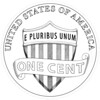 "Regarding the design of the new cent, at last night's meeting of the Indianapolis Coin Club I heard several folks say that they had not liked the new design in print, but liked it a lot in the hand."
"Regarding the design of the new cent, at last night's meeting of the Indianapolis Coin Club I heard several folks say that they had not liked the new design in print, but liked it a lot in the hand."
Ed Krivoniak writes:
 I recently ran all my Internet searches again and found a copy of the original contract between the Mexican government and the Pittsburg and Mexican Tin Mining Company! The really interesting thing about that is that the company name was misspelled. Fin was substituted for Tin.
This was not a scanning error since the pages were photographed.
I recently ran all my Internet searches again and found a copy of the original contract between the Mexican government and the Pittsburg and Mexican Tin Mining Company! The really interesting thing about that is that the company name was misspelled. Fin was substituted for Tin.
This was not a scanning error since the pages were photographed.
I have also noted that at least half of the websites that I used for information in the past no longer exist! I think it would be wise to caution any other researchers to print hard copies of their material as they find it.
Tom Fort forwarded this article from the L.A. Times about a contest to encourage rare book collecting among college students: Forget the frat party, there's book collecting to be done (latimesblogs.latimes.com/jacketcopy/2010/02/college-book-collecting.html)
Dennis Tucker forwarded this "inspirational story from Columbia --- related not to numismatics, but to books..." Teaching kids to read from the back of a burro (www.cnn.com/2010/LIVING/02/25/cnnheroes.soriano/index.html?hpt=C1)
Another E-Sylum reader sends this story about a ceremony in Austin, TX, noting that: "... toward the end of the story; man receives three challenge coins, first person to get them from the three agencies that issue them" Austin holds moment of silence for plane attack (www.kvue.com/news/City-Holds-Moment-of-Silence-in-Attack-85362197.html)
THE BOOK BAZARRE
DICKIN MEDAL AWARD CEREMONY HELD FOR BOMB-SNIFFING DOG TREO
Macclesfield's hero soldier dog Treo has had his day once again - after being awarded the animal equivalent of the Victoria Cross.
The four-legged army trooper yesterday (Wednesday) received the People's Dispensary for Sick Animals (PDSA) Dickin Medal from HRH Princess Alexandra, under the proud gaze of handler and former Tytherington man, Sergeant David Heyhoe.
Treo, an eight-year-old black labrador, earned the accolade for finding deadly roadside bombs on two separate occasions while patrolling in Afghanistan.
He retired from active service in August last year and now lives with his former handler at the family home.
His detection work prevented death and serious injuries to the patrolling soldiers, according to Sgt Heyhoe, who lived in Tytherington and Rainow for a number of years and has previously met the Prime Minister thanks to his heroic work with Treo.
To read the complete article, see:
Medal of honour for hero dog Treo
(www.macclesfield-express.co.uk/news/s/1193835_
medal_of_honour_for_hero_dog_treo)
Dave Hirt writes:
I'm still here in Europe, but coming home soon. In the Feb.7 E-Sylum there was a story of the army bomb sniffing dog Treo to get the Dickin Award. Today on the Hungarian TV news, it showed him getting his award. It was much more interesting because of what I had read in The E-Sylum.
An eight year old tabby cat from Wootten Bassett has today been awarded the animal equivalent of the Victoria Cross for his heroic work in Afghanistan.
Scratcher the cat was presented with his medal by his owner Gladys Francis in an emotional ceremony that unfortunately wasn't attended by any member of the Royal family.
'There was no sign of him for four days and not one person called me about him, then just as I was about to build a little shrine for him in the back garden he turned up. He was covered in dust and he seemed a little tired but it was only after his second bowl of Whiskers that he confessed to his wearabouts for the last few days.'
'He'd been on a secret mission, he told me. He boarded a plane with some soldiers and was flown out to Sangin where he left on foot across some treacherous terrain. He negotiated several minefields, single handedly defeated a Taliban stronghold and located the hiding place of Osama Bin Laden where he was taken prisoner. He managed to escape after tricking guards and headed back to the British army camp where he reported his findings then caught the next plane home.'
'He's a true hero. Much better than that labrador who apparently sniffed out a couple of bombs. Although if you read the newspapers you'd think that dog had single-handedly won the bloody war.'
'I've seen that dog round here and all it does is piss on lamposts and chase pigeons.
To read the complete article, see: Heroic Cat awarded Victoria Cross for Bravery (www.thespoof.com/news/spoof.cfm?headline=s3i69662)
1859 MASSACHUSETTS TIME CAPSULE YIELDS COINS AND DOCUMENTS
A time capsule found in a small Massachusetts town includes two old coins. The finders are wisely going to inquire with collectors about how the clean the coins.
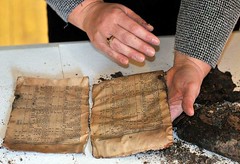 The jar was a time capsule placed inside the Hapgood Cemetery monument on July 4, 1859, when it was dedicated and erected. It remained inside the monument, forgotten, until two Athol High School teachers began researching what is believed to be the town's oldest cemetery. The research led them to discover that when the monument was placed to denote the poorly defined cemetery, where graves are mostly unmarked, a record of the event was kept and tucked away for a future generation.
The jar was a time capsule placed inside the Hapgood Cemetery monument on July 4, 1859, when it was dedicated and erected. It remained inside the monument, forgotten, until two Athol High School teachers began researching what is believed to be the town's oldest cemetery. The research led them to discover that when the monument was placed to denote the poorly defined cemetery, where graves are mostly unmarked, a record of the event was kept and tucked away for a future generation.
Yesterday the town held two events connected with the discovery of the capsule. The first was at the cemetery, where workers from Athol Granite re-erected the monument with a new time capsule in it. The second was in Town Hall, where Ms. Burnham opened the old capsule to see if anything in it could be salvaged.
Those involved with the process had not much hope of finding intact papers. When the capsule was taken out of the monument Feb. 2, it was cracked. Through the glass, it looked as if the material inside was hopelessly decayed.
What they thought they saw was not what they got.
"I can't believe there is that much savable," Susannah Whipps-Lee of the Athol Historical Society said at the time.
Yesterday, Ms. Burnham unrolled four sets of documents that included an annual report of the town's schools, a list of assessed properties in town, a report of the 1850 town centennial and what appears to be the equivalent of today's pocket organizers. All the documents were damaged, but most of them could be read.
Along with the remains of some of the documents, two coins fell out. The coins appear to be pennies, although Ms. Burnham said she will ask local coin collector and historian J.R. Greene for advice on what can be used to safely clean them. She said they are likely pennies from 1859, but the faces of the coins are obscured by accumulated material.
Ms. Burnham plans to leave the documents out to dry on blotting paper. Once they are dry, they will be sent to document specialists for preservation. Then they will be returned to be displayed in town along with the coins and the glass jar.
To read the complete article, see: Time capsule spills forth history (www.telegram.com/article/20100219/NEWS/2190516/1116)
ARTICLE HIGHLIGHTS MICHIGAN MAN'S WWII SHORT SNORTER
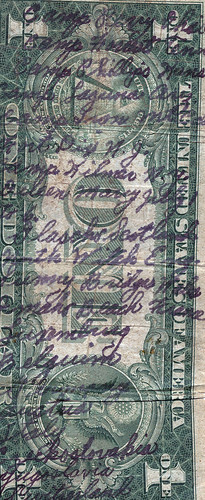 The 1935 one-dollar bill, its edges frayed and its color faded, reads like a World War II history book.
The 1935 one-dollar bill, its edges frayed and its color faded, reads like a World War II history book.
Scrawled on the back of the bill is a list of some of the most notable spots in the history of the war. The entries start with the U.S. at Camp Perry, Ohio, and end with the former eastern European nation of Yugoslavia.
In between are some of World War II's most historic spots, including Omaha Beach, France, where thousands of Americans lost their lives in one of the war's defining periods.
But who carried the worn dollar continues to puzzle Ed Sechen, an 82-year-old Norton Shores resident who was handed the bill by a friend 20 years ago.
"It must be from a soldier from that time," said Sechen, a lifelong coin collector who was attracted by the history of the bill. "It looks like he went to a lot of different places."
It wasn't uncommon for soldiers to record a list of places they visited on a dollar bill, said John McGarry III, executive director of the Lakeshore Museum Center in Muskegon. The bills event had a name: a "short snorter," McGarry said.
Some service members had other soldiers sign their dollar bills during their travels.
"First of all, you want something easy to carry and that you're not going to lose," McGarry said. "You can fold up a dollar bill and put it in your pocket."
He said the practice dates back at least to the Civil War when soldiers would write the names of locations they visited on canteens.
To read the complete article, see:
Short snorter' dollar bill is a piece of World War II history -- and mystery
(www.mlive.com/news/muskegon/index.ssf/2010/02/
short_snorter_dollar_bill_is_a.html)
U.K. WOMAN ARRESTED FOR FAILING TO REPORT COIN FOUND AS A CHILD
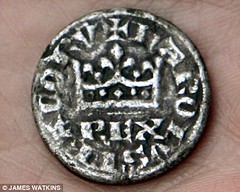 A woman who found a 700-year-old coin in her garden as a child has become the first person to be convicted of failing to hand in suspected treasure.
Kate Harding, 23, was prosecuted under the Treasure Act after she ignored orders to report the rare find to a coroner.
A woman who found a 700-year-old coin in her garden as a child has become the first person to be convicted of failing to hand in suspected treasure.
Kate Harding, 23, was prosecuted under the Treasure Act after she ignored orders to report the rare find to a coroner.
A court heard the silver piedfort marking Charles IV's ascension to the French throne in 1322 was discovered by Miss Harding 14 years ago as she worked in the garden with her mother.
Following her mother's death a short time later, Miss Harding kept the 1.4g item as a memento until she eventually approached museum experts with it last year who identified it as a piedfort, but she did not inform the coroner.
The exact use of piedforts is unknown. They are generally thicker than coins and were not used as currency. Experts have suggested they were used as guides for mint workers or as reckoning counters for officials.
Only three others have been found in the UK. One found in 2007 was bought by the British Museum for £1,800.
Read more: http://www.dailymail.co.uk/news/worldnews/article-1253991/Woman-coin-worth-2-000-garden-prosecuted-reporting-treasure.html#ixzz0gnIWq2D3
To read the complete article, see:
Woman who found coin worth £2,000 in garden becomes first to be prosecuted for not reporting treasure
(www.dailymail.co.uk/news/worldnews/article-1253991
/Woman-coin-worth-2-000-garden-prosecuted-reporting-treasure.html)
DEFACED CURRENCY GALLERY ON FLICKR
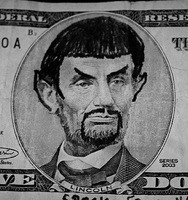 Someone has created a collection on the Flickr web site of images paper money sporting graffiti, particularly defaced portraits. It's a kind of folk art in a way, like Hobo nickels without the craftsmanship. "Assassination" is tasteless, but some others are amusing.
Someone has created a collection on the Flickr web site of images paper money sporting graffiti, particularly defaced portraits. It's a kind of folk art in a way, like Hobo nickels without the craftsmanship. "Assassination" is tasteless, but some others are amusing.
Here's Abe Lincoln as Spock from Star Trek. Below are a few examples of the royal treatment of the Queen on Canada's currency. -Editor
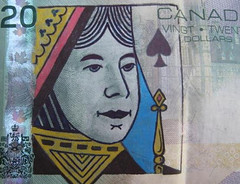

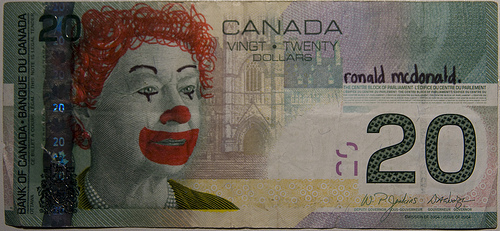
To read the complete article, see: Defaced presidents on Flickr (boingboing.net/2008/03/31/defaced-presidents-o.html)
FENG SHUI: GLUE GOLD COIN TO YOUR DOORSTEP FOR LUCK
HERE'S a story which will have you rushing home to glue a gold coin to your doorstep. A retired Sydney man who did just that after reading an article about feng shui became an instant millionaire thanks to a stroke of good fortune. The ex-policeman, aged in his 50s, picked a winning ticket in the latest BoysTown charity lotto, netting him a luxury house on the Sunshine Coast worth more than $1.2 million. He reckons his stroke of luck was all down to the gold coin. Since gluing it in place in November, he's also won two lotto prizes worth more than $1000. "I had lost a fair bit of money, so I thought ... why not!" he said of adopting the feng shui practice. "I was pretty embarrassed about it at the time."
To read the complete article, see:
Man wins $1 m after gluing coin to step
(www.news.com.au/breaking-news/man-wins-1-m-after
-gluing-coin-to-step/story-e6frfku0-1225833137949)
Gold symbolises wealth. Check. Coins represent money. Check. The front door represents good energy coming into your house. Check.
So when a Sydney man glued a gold coin to his front doorstep in November, he believed he had checked all the feng shui boxes for a windfall - which he got after winning more than $1.2 million at the BoysTown charity lotto.
But had the ex-policeman unlocked an ancient Chinese art of hitting the jackpot?
"I have coins in my front door, but that doesn't mean they are going to win a million bucks," said Wiggins, who is president of the Association of Feng Shui consultants.
"Is this part of traditional feng shui? Not it's not."
To read the complete article, see: Belief in feng shui 'triggers jackpot win' (www.smh.com.au/nsw/belief-in-feng-shui-triggers-jackpot-win-20100223-oxz5.html)
FEATURED WEB SITE: PARTHIA.COM
This week's Featured Web site is suggested by John and Nancy Wilson, who write:
This is Chris Hopkins' site, a product of over ten years of effort. He described it as follows in 2007:
"Parthia.com is an noncommercial educational web site about the Parthians and their sub-kingdoms of Characene, Elymais and Persis. The primary focus is on numismatics, but the site is not just a virtual coin collection. Visiting Parthia.com, will give you insight into Parthian art, history, archaeology, geography and more. It is an excellent place to find references to books, articles, maps and other resources for further study."
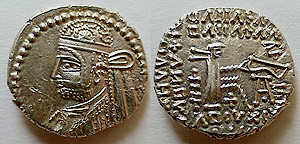
www.parthia.com

